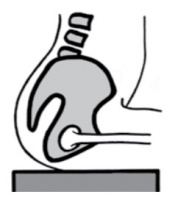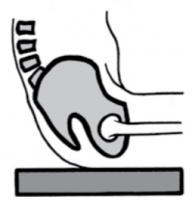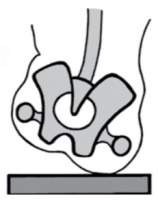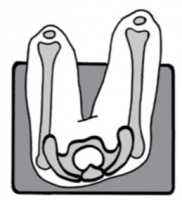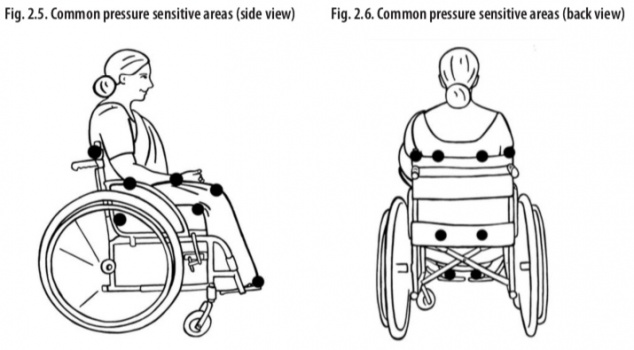Introduction
Wheelchair users are people who already have a wheelchair or who can benefit from using a wheelchair because their ability to walk is limited. The needs of each wheelchair user will vary. All wheelchairs provide seating and postural support as well as mobility. Good postural support is important for everyone, especially for people who have an unstable spine or are likely to develop secondary deformities. The significance of good seating and postural support can mean the difference between the user being active and an independent member of society and the user being completely dependent and at risk of serious injury or even death. Every appropriate, well-fitting wheelchair provides the user some postural support. The backrest, cushion, footrests and armrests all provide postural support when adjusted to suit the wheelchair user’s size. [1][2]
Posture
What is Posture
Posture is the attitude assumed by body either when the body is stationary or when it is moving. Posture is attained as a result of co-ordinated action of various muscles working to maintain stability. Posture in easy terms can be understood as the position in which you hold your body when standing or sitting.[3]
Most wheelchair users spend many hours sitting. This means that their wheelchair is not just a mobility aid. It also helps to support them in sitting upright comfortably. Wherever possible, a well-fitting wheelchair should support wheelchair users in sitting in an upright or neutral posture. [1]
Benefits of Upright Posture
Sitting upright helps wheelchair users in many ways including; [1]
- Health: an upright posture helps with digestion of food and breathing;
- Stability: an upright posture is more stable;
- Weight Distribution: when sitting upright body weight is evenly distributed – this helps to reduce the risk of pressure sores;
- Comfort: when body weight is distributed evenly, it is more comfortable for the user;
- Preventing Problems with Posture: sitting upright will help to reduce the chance of developing deformities of the spine in the future;
- Self-Esteem and Confidence: sitting upright can help wheelchair users feel better about themselves.
Even though sitting upright has many benefits, without postural support it can be hard to stay in this posture all day. This is why people without a disability use different postures throughout the day. For a wheelchair user who sits in a wheelchair all day, the wheelchair needs to provide enough support to help the user to sit upright comfortably. [1]
| From the Side | From the Front |
|---|---|
Look from the front and check:
|
Look from the front and check:
|
Role of the Pelvis in Posture
The pelvis is the base for sitting upright. To be strong and stable, a building needs a solid foundation. in the same way, to be stable when sitting the pelvis must be strong and stable. When the wheelchair user is sitting upright, the pelvis should be level when viewed from the front and upright or slightly tilted forward when viewed from the side. Any changes in the position of the pelvis will cause a change in the other parts of the body. The pelvis moves in different ways. The table below shows four different pelvic movements and how the body changes when each movement is made.
| Movement | Illustration | Changes in the Body |
|---|---|---|
| Anterior Pelvic Tilt
(Rolling Forward) |
The body straightens out with the shoulders pulled back.
There is an increase in the curve of the spine above the pelvis. |
|
| Posterior Pelvic Tilt
(Rolling Back) |
The body becomes rounded with the shoulders forward. | |
| Lateral Tilt
(Tilting Sideways) |
The body laterally tilts or bends sideways. | |
| Rotation | The body rotates |
Postural Support
All body contact surfaces provide seating and postural support. Together, these parts of the wheelchair help the user to maintain a comfortable and functional posture and to provide pressure relief. This is very important for users who have problems with skin sensation. The common areas where likely problems might occur are shown in Fig.1. [2]
Every well-fitting wheelchair provides the user some postural support. The seat, backrest, armrest, cushion, and footrests all provide some element of postural support when adjusted to suit the wheelchair user’s size. The following components or features of a wheelchair will affect how well the wheelchair fits and how well it helps the user to sit upright. [2][4]
| Device | Characteristics |
|---|---|
| Seat Base | Wheelchair seats may be either solid or slung.
Sling seats and solid seats should be used with cushions designed or modified for use on a sling seat and solid seat, respectively Wheelchair seats must be level from side to side and have a continuous surface with no breaks that might cut or pinch the user’s skin. The angle of the seat, in relation to the horizontal, should be between 0 and 12 degrees (with the front portion of the seat higher than the rear portion of the seat). A range of seat sizes should be available to fit a range of body sizes. |
| Backrest | The backrest provides users the necessary postural support. Backrests may be slung or solid but should all have some element of padding / cushioning.
The angle between the seat and the backrest (seat to back angle) should be between 80 and 100 degrees. Different backrest heights should be available to cater to each individuals needs. The backrest should support the normal curvature of the spine with the middle of the back able to rest further back than the back of the pelvis. |
| Armrest | Users should use armrests only for temporary postural support. If needed, other postural support options should be used to keep the user’s arms free for activities such as propelling.
|
| Cushion | Cushions provide comfort, maintain pelvic position, relieve pressure, and also provides support to stop the user from sliding forward in the wheelchair. An inadequate pressure-relief cushion is the one component of a wheelchair that is most likely to cause pressure sores, serious injury or premature death. |
| Footrest | The footrest provides users with support for their feet and legs.
|
All elements of the wheelchair should be strong and durable enough to withstand the wear and tear, including static forces, impacts and fatigue stresses placed on it by the user and to keep the user safe.
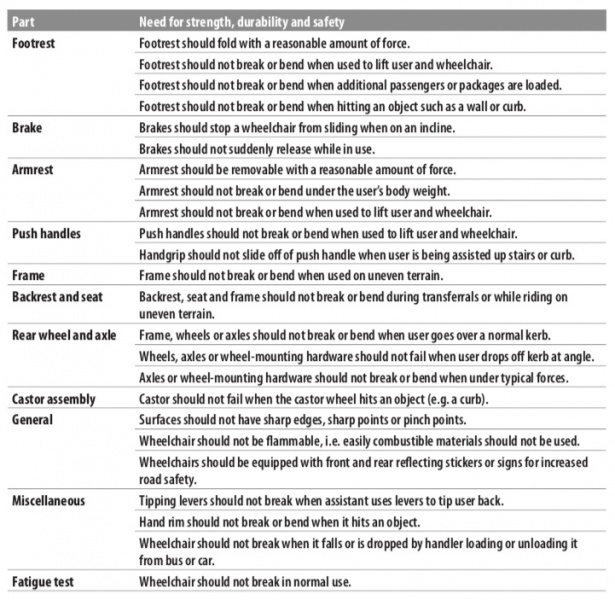

When is Additional Postural Support Needed?
Many children and adults need additional postural support in their wheelchair. Some people are not able to sit upright without additional support. Some people need a lot of additional support, and some need just a few changes to their wheelchair. Additional postural support can be provided in different ways. Some solutions are very simple, and can be made in a basic workshop. Other solutions may be more complicated. [1]
People need additional postural support for different reasons. Usually it is clear when a wheelchair is not giving enough support to help the wheelchair user sit upright. Often wheelchair users, or the family member / caregiver will have good suggestions themselves about what further supports they feel may need. Reasons for needing additional support include: [1]
- Cannot Sit Upright;
- Uncontrolled Movements or Spasms;
- Joint Stiffness;
- Tightness;
- Weakness;
- Fatigue;
- Pain or Discomfort;
- Difficulty Balancing.
Additional postural support can be provided by means of a Postural Support Device (PSD), a physical device that provides additional postural support. Postural Support Device is an essential element of intermediate level wheelchair service. This includes any addition or modification to a wheelchair for providing additional postural support. [1]
How Does Additional Postural Support Help?
There are four very important ways that additional postural support can benefit wheelchair users; [1]
Improves Balance, Posture and Stability
Improving balance, posture and stability can help a wheelchair user to carry out activities that are not possible or very difficult for them without additional postural support.
Improves Comfort
Additional postural support can make a wheelchair much more comfortable and can increase the time wheelchair users are able to sit in their wheelchair before becoming tired.
Prevent the Development of Pressure Sores
A pressure sore can develop very quickly. Good postural support helps to prevent pressure sores by making sure that one part of the body is not overloaded. One benefit of sitting upright is that weight is evenly distributed. This helps to reduce the risk of a pressure sore.
When a wheelchair user does not sit upright, their weight is unevenly distributed. One part of their body will take more weight than other parts. If that additional weight is on skin, which lies over a bony area, there is a high risk of pressure sores.
Examples of bony areas include the seat bones (ischial tuberosity), ribs, hips (trochanters), spine (vertebra) or tail bone (coccyx).
When a wheelchair user is not well supported, he/ she tends to slide on the seat. This causes shear, which leads to pressure sores. Sitting well supported prevents sliding and shearing.
Helps to slow down or prevent the development of problems with posture in the future
Good postural support can prevent problems with posture developing. If a problem with posture has already started, good postural support can slow down or prevent this from getting worse. Good postural support in lying, sitting and standing, started as early as possible is important.
Eating and Drinking Safely
Some wheelchair users who have difficulty sitting upright also have problems with swallowing safely. For these people, eating and drinking can be uncomfortable, sometimes frightening, and often dangerous. When people have difficulty swallowing safely, small pieces of food and drink may go into the lungs. This can cause a chest infection, making them very ill or even choking leading to death.
Additional postural support in a wheelchair ensures that the wheelchair user can sit upright when eating and drinking. Improving postural support is just one part of the solution for anyone who has problems with swallowing. If at all possible, children or adults with problems swallowing should be referred to someone who has experience in managing this. This could be a paediatrician, speech language therapist, or any allied health or community health worker who has knowledge and training in helping people manage problems with swallowing.
What do Wheelchair Users Want?
Wheelchair users want to be comfortable and able to get on with their lives. It is important that additional support in the wheelchair does not make day-to-day activities harder. [1]
For example, additional postural support should not interfere with transferring in and out of the wheelchair, propelling the wheelchair, accessing desk or workspace and transport.
A wheelchair and additional postural support should always; [1]
- be practical and easy to use;
- be comfortable and not cause additional discomfort;
- help wheelchair users to do things and not make them more difficult;
- look good and not be too ‘obvious’.
Sometimes wheelchair users find it hard to get used to a wheelchair with additional postural support. There are different reasons for this including;[1]
- the wheelchair user may be used to sitting in a certain way. The additional postural support, which changes their habitual posture, feels uncomfortable or restrictive;
- the wheelchair user may not understand why the additional support has been prescribed;
- the wheelchair user may feel the additional postural support does not look good and makes his/her disability more obvious.
For these reasons, it is very important that wheelchair service personnel work closely with the wheelchair user and their family/caregiver throughout the assessment, prescription, fitting, user training and follow up steps. Always discuss solutions with the wheelchair user and always respect their input and final decisions. The best way to make sure additional postural support will be used by wheelchair user is to; [1]
- fully involve the wheelchair user and their family member/caregiver in their assessment, prescription, fitting, user training and follow up;
- help the wheelchair user and their family member/caregiver to understand why and how additional postural support will help them;
- always let the wheelchair user make the final decision.
References
- ↑ 1.001.011.021.031.041.051.061.071.081.091.101.111.121.13 Sarah Frost, Kylie Mines, Jamie Noon, Elsje Scheffler, and Rebecca Jackson Stoeckle. Wheelchair Service Training Package – Reference Manual for Participants – Intermediate Level. Section A. Core Knowledge.World Health Organization, Geneva. 2013
- ↑ 2.02.12.2 William Armstrong, Johan Borg, Marc Krizack, Alida Lindsley, Kylie Mines, Jon Pearlman, Kim Reisinger, Sarah Sheldon. Guidelines on the Provision of Manual Wheelchairs in Less Resourced Settings. World Health Organization; Geneva: 2008.
- ↑ Gardiner MD. The Principles of Exercise Therapy. Bell; 1957.
- ↑ Sarah Frost, Kylie Mines, Jamie Noon, Elsje Scheffler, and Rebecca Jackson Stoeckle. Wheelchair Service Training Package – Reference Manual for Participants – Basic Level. Section A. Core Knowledge.World Health Organization, Geneva. 2012
- ↑ William Armstrong, Johan Borg, Marc Krizack, Alida Lindsley, Kylie Mines, Jon Pearlman, Kim Reisinger, Sarah Sheldon. Guidelines on the Provision of Manual Wheelchairs in Less Resourced Settings. World Health Organization; Geneva: 2008.

